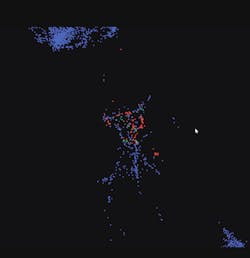In early July, a partner with McKinsey & Company demonstrated how a computer model trained on a vast library of chemical compounds could help researchers identify new molecules exponentially faster than they could in the past.
The enabling technology is generative artificial intelligence (AI). Much of the buzz around AI has focused on content generation in various professions ranging from journalism to marketing and law. But generative AI also shows promise as a powerful tool in industrial applications.
For the chemical industry, it could revolutionize the way manufacturers develop new formulations or help them parse through compliance issues in contracts with significantly less effort. These were some of the possibilities that McKinsey presenters discussed during a webinar on July 6, entitled “GenAI in Chemicals – Delivering on the Promise.” During the hourlong presentation, Matej Macak, a partner in the management consultancy firm’s London, U.K., office showed how AI could speed R&D using a model that resembled a constellation of stars.
In his example, an AI tool mapped molecules, represented as small dots in a cluster, within a two-dimensional space to identify new refrigerants. Molecules spaced closer together had similarities in structure and functional properties, Macak explained. Red molecules represented those that had already been tested for refrigerant properties, while molecules in blue had not been tested.
“Why is this potentially very exciting?” said Macak during his presentation. “You can see that a lot of the refrigerants cluster in specific areas of the chemical space, which is what you would expect if the model somehow captures the relevant relationship between the structure and functional properties of the molecule and the application for refrigerants.”
This model can show specific desired properties, such as boiling pressure, to help locate potential refrigerants. This relational information could be particularly useful for identifying safer or more sustainable compounds, Macak said.
“In our experience, you can meaningfully accelerate the discovery process by two or three times and find molecules that can be much better in specific properties that you are interested in,” Macak said.
The pharmaceutical industry has been actively using AI for generative design. In a June report, McKinsey cited the example of a biotech pharmaceutical company called Entos that used generative AI along with automated synthetic development tools to design small-molecule therapeutics. At Ohio State University, researchers have created an AI framework called G2Retro to speed the drug-discovery process.
A research team, led by Xia Ning, lead author of the study and an associate professor of computer science and engineering at Ohio State, trained the AI platform using a dataset of 40,000 chemical reactions collected between 1976 and 2016. The system “learns” from the molecular representations and applies “deep neural networks to generate possible reactant structures that could be used to synthesize them,” Ohio State News reported in a May 23 article.
The G2Retro system can identify hundreds of new reaction predictions in minutes, according to the article.
Similarly, McKinsey trained its model on a vast library of chemical compounds and chemical matter from various databases. While tools, like GPT-4, are trained on language to generate text, molecular AI tools leverage chemistries to predict a new bond, Macak said.
Generative AI may also help chemical manufacturers deconstruct complex contracts. In this example, McKinsey researcher Simon Barres showed how users can query a generative AI tool to extract key information from documents. During the demo, Barres asked the AI “agent” to summarize the contract, including the parties involved, the crucial terms, duration and other critical factors. Users also can ask the agent to identify compliance issues.
“From this, it's much quicker for a lawyer or an operator to port to the documents and start drilling down a bit more,” Barres said.
While generative AI shows promise in industry, questions remain about its potential impact on society. Last year, a Scientific American article explained how bad actors could use AI drug-discovery systems to create chemical weapons. In June, Pricewaterhouse Coopers reported that policymakers around the world are working on regulations to make AI safer.
For example, the European Union proposed additions to its Artificial Intelligence Act to require that AI developers “guarantee robust protection of fundamental rights, health and safety and the environment, democracy and rule of law.” This includes assessments and risk-mitigation strategies, along with design, information and environmental requirements, according to the PwC report.
About the Author
Jonathan Katz
Executive Editor
Jonathan Katz, executive editor, brings nearly two decades of experience as a B2B journalist to Chemical Processing magazine. He has expertise on a wide range of industrial topics. Jon previously served as the managing editor for IndustryWeek magazine and, most recently, as a freelance writer specializing in content marketing for the manufacturing sector.
His knowledge areas include industrial safety, environmental compliance/sustainability, lean manufacturing/continuous improvement, Industry 4.0/automation and many other topics of interest to the Chemical Processing audience.
When he’s not working, Jon enjoys fishing, hiking and music, including a small but growing vinyl collection.
Jon resides in the Cleveland, Ohio, area.


